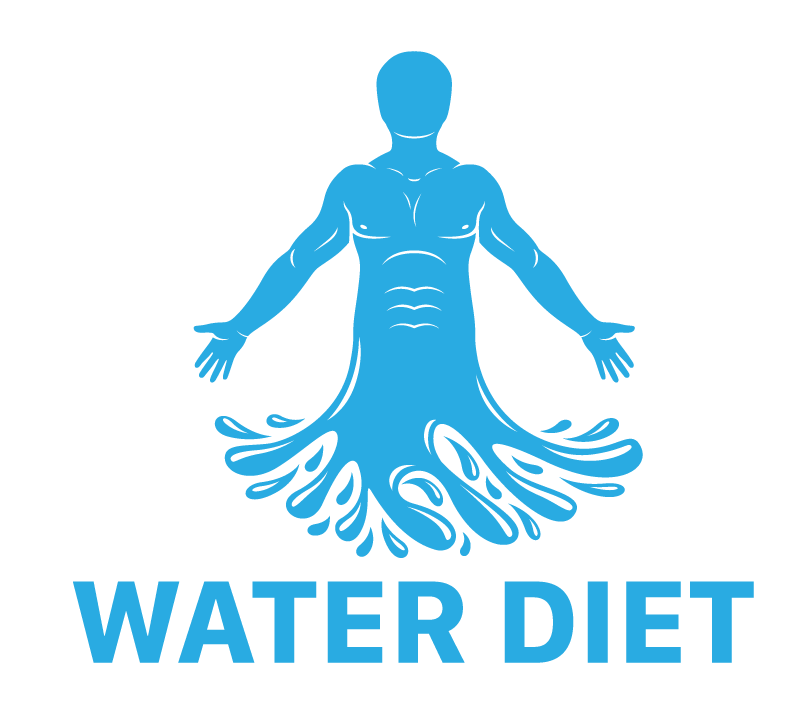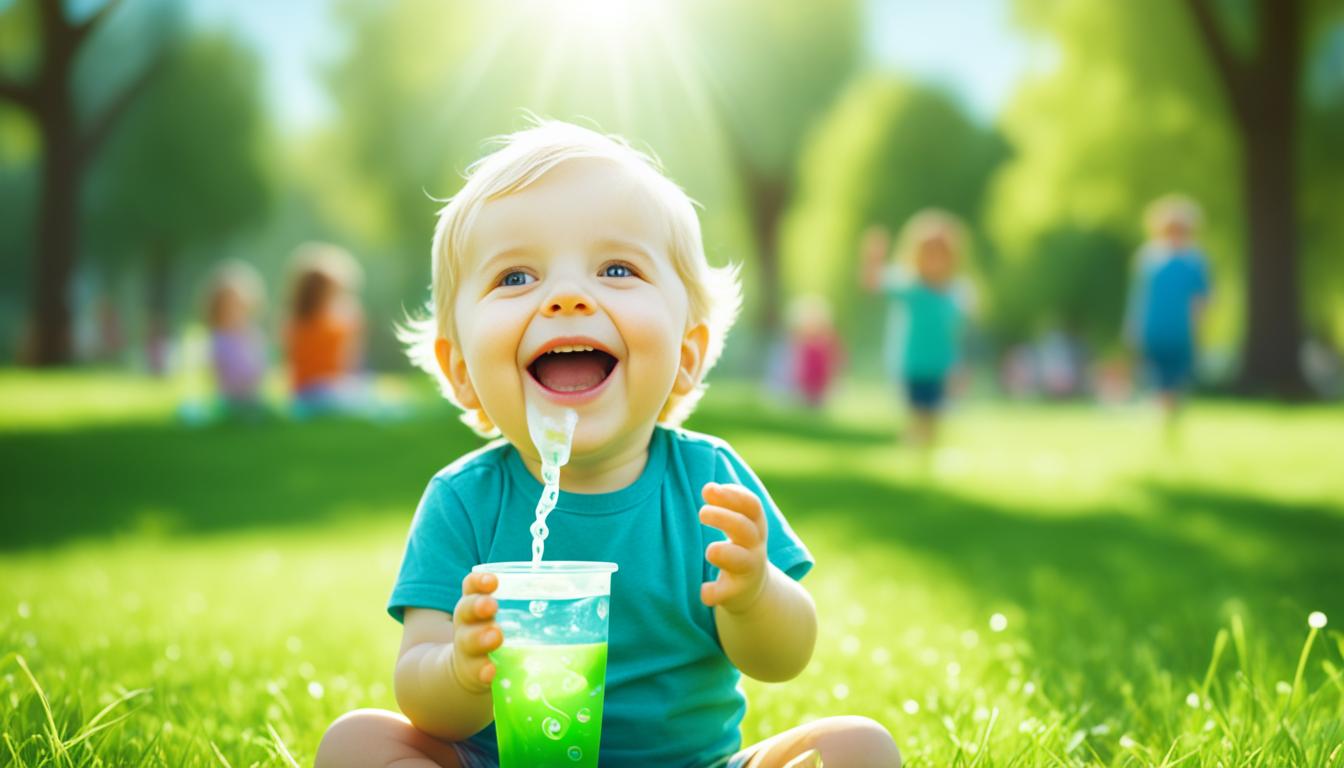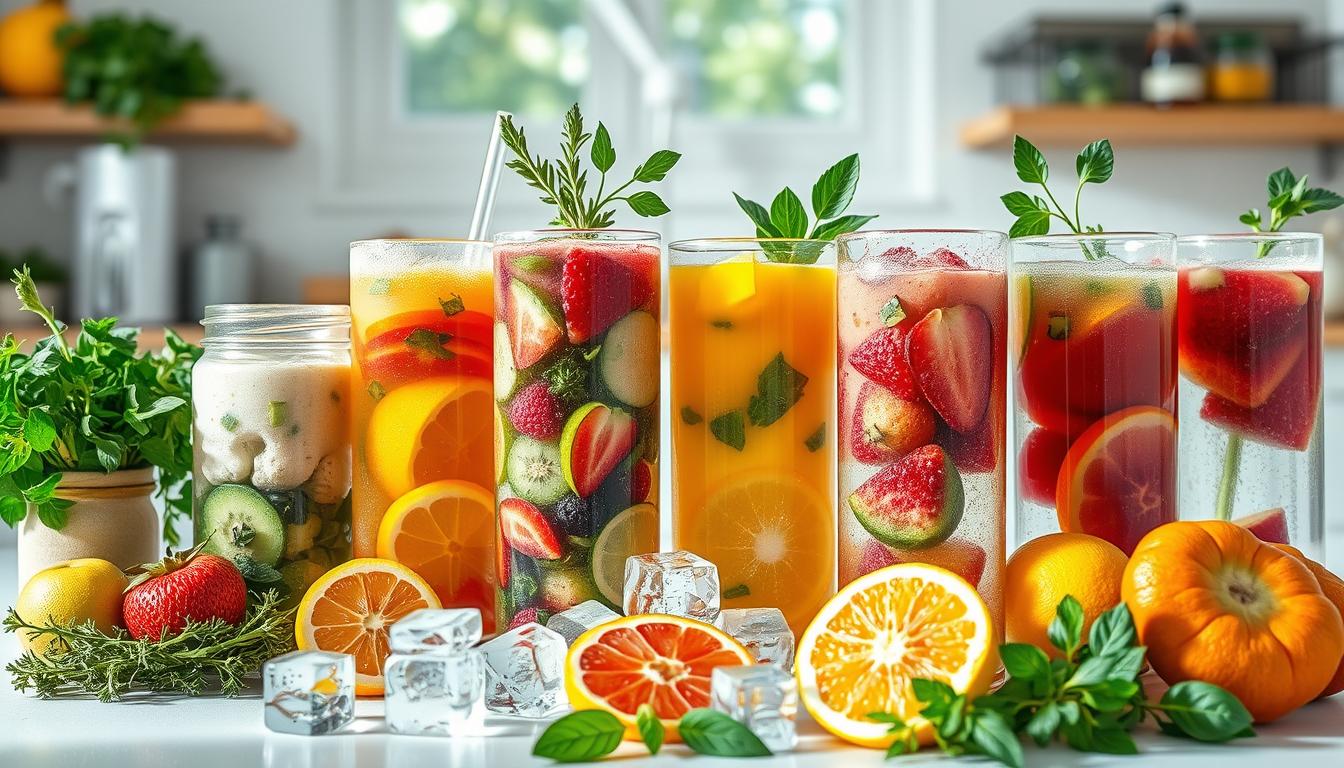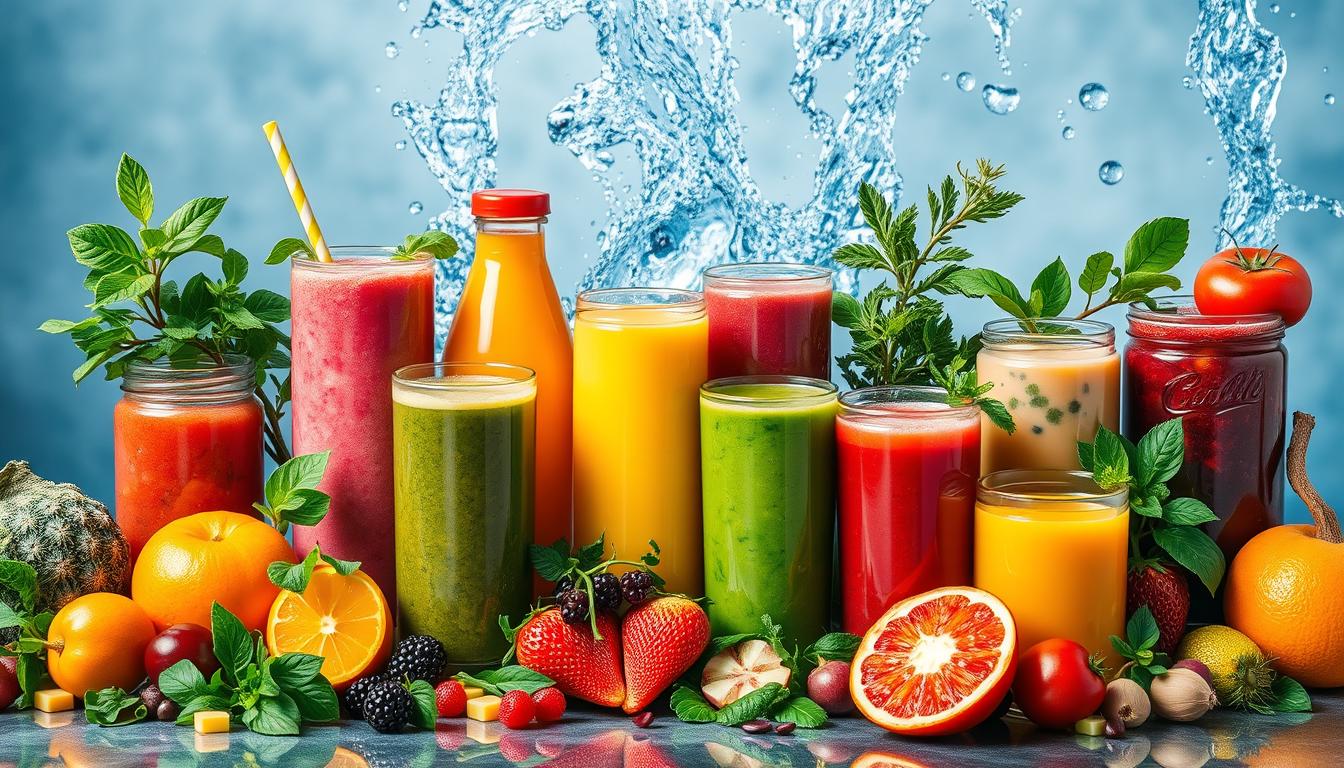Water is crucial for our kids, acting like a tiny oasis for their body. Knowing about hydration for kids is key to their health and energy. It helps regulate body temperature, supports digestion, and is vital for their physical activities. The benefits of staying hydrated are clear for a child’s growth.
Whether they’re playing, in school, or doing sports, these hydration tips for kids show caregivers how to keep them active and healthy.
Understanding the Importance of Water for Children’s Health
Ensuring kids have enough water is key to their growth and health. We importance of water for children must stress it; it’s crucial for their body and mind. We’ll explore how water helps the body and what happens if kids don’t get enough.
The Role of Hydration in Maintaining Body Functions
Water is crucial for a child’s health. It helps control body heat and make fluids like saliva. Keeping hydrated boosts brain power, helps kids focus, and learn better.
Being well-hydrated also improves muscle work and lowers tiredness. This is especially important for staying hydrated during sports for kids. The table below shows how much water kids need to keep these functions going.
| Age Group | Daily Water Intake | Additional Needs |
|---|---|---|
| 4-8 years | 5 cups | Extra intake during sports/heat |
| 9-13 years | 5-6 cups | Increased intake during physical activity |
| Teenagers | 6-8 cups | Ample fluids for sports, especially in high temperatures |
Recognizing the Higher Risk of Dehydration in Young Kids
Babies under six months old can get dehydrated fast, which can be dangerous. Fever, diarrhea, and some medicines can increase their risk. Not drinking enough fluids, especially when sick or in hot weather, is also a problem. We must encourage kids to drink more water to avoid dehydration.
It’s key for parents, coaches, and teachers to push the importance of water for children. This helps not only with their current need for water but also teaches them healthy habits for life.
Understanding how water affects a child’s health and their risk of getting dehydrated is vital. Parents and guardians need to make sure kids drink enough water every day. This is crucial before, during, and after sports and other physical activities.
Identifying Dehydration: Signs to Look Out For
Spotting signs and symptoms of dehydration in kids is key to their health. It’s important to know these signs to quickly provide the right dehydration treatment. This prevents any serious problems from happening.
Subtle Symptoms of Mild Dehydration
Mild dehydration might not be obvious, especially in busy or active kids. Signs to watch for include being more thirsty than usual, having slight headaches, feeling dizzy, and dry mouth or lips. The color of the pee is also a clue; dark yellow means they might need more water.
Offering kids easy access to water helps them drink more. This is a simple way to keep them hydrated.
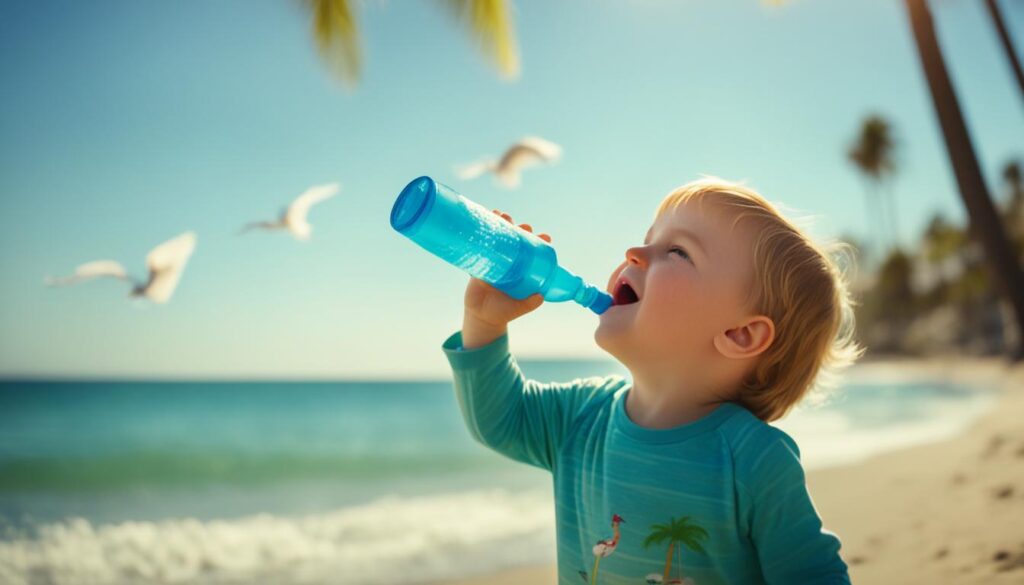
When to Seek Medical Attention for Severe Dehydration
Without proper care, mild dehydration can get worse fast. Severe dehydration shows through serious signs. These include being very thirsty, feeling very tired, peeing less, having cold hands and feet, a fast heartbeat, and sunken eyes. Such signs mean a child needs help from a doctor right away to avoid more health issues.
Watching for signs and symptoms of dehydration is just one part of keeping kids hydrated. Making sure they drink lots of water, especially during exercise, is crucial. Try making water fun by using colorful cups or adding fruit slices. This can really help encourage kids to drink water. Such steps are great for avoiding dehydration and keeping kids healthy.
Hydration For kids: Best Practices for Keeping Them Hydrated
One of the best ways to keep kids hydrated is to make sure they drink water often. Caregivers are key in creating habits that make kids choose healthy drinks for children over sugary ones. Here are some useful practical hydration tips for kids to prevent dehydration.
- Encourage kids to carry a refillable water bottle for easy access to water anytime.
- Create a “hydration station” at home with water that has fruit slices like oranges or berries.
- Include hydrating foods such as cucumbers, watermelon, and oranges in their diet to boost fluid intake invisibly.
- Opt for milk as an alternative drink, providing essential nutrients and hydration without the excessive sugars found in some store-bought juices.
Tracking your child’s water intake can be fun and educational. The table below shows creative ways to help kids meet their daily water intake goals:
| Age Range | Daily Water Intake | Fun Hydration Tip |
|---|---|---|
| 4-8 years | Approximately 5 cups | Colorful water bottles with favorite characters |
| 9-13 years | 5-6 cups for girls, 6-8 cups for boys | Fruit ice cubes or popsicles |
| Teenagers | 7-8 cups for girls, 8-10 cups for boys | DIY sports drinks with natural fruit juice and a pinch of salt |
It’s not only about how much water children drink. How you offer it matters too. Making hydration fun and appealing encourages children to drink more water.
Remember, a hydrated child is a happy, energetic, and healthy child. It’s crucial to adopt these hydration practices for our young ones’ well-being.
Create a Habit: Encouraging Kids to Choose Water Over Sugary Drinks
In the tug-of-war between sugary drinks vs water, teaching kids to drink water is key. The choices we make now can affect their health for years. Adults have a big role in showing kids the way. Let’s talk about how adults can set the right example and make water the fun choice.
Modeling Healthy Choices as Adults
To get kids to love water, adults should drink it too. When kids see their heroes choosing water over soda, they will likely do the same. This not only highlights the benefits of water but also builds a culture of health.
Refreshing Alternatives: Making Water Appealing to Children
Making water fun for kids is easy with a little creativity. Adding fruit or natural flavors can make water exciting. Also, cool straws and colorful bottles can make drinking water special for them.
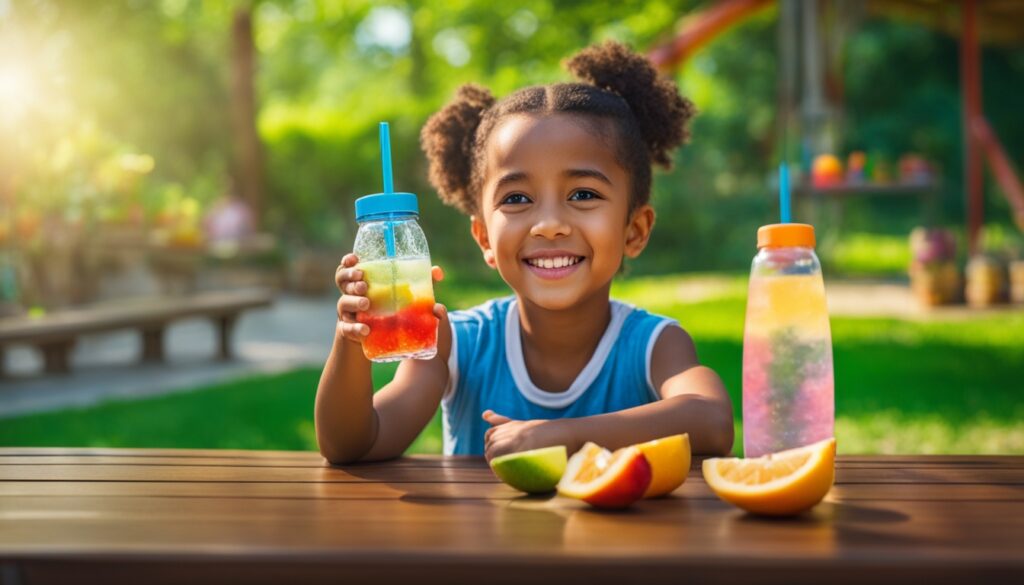
| Strategy | Description | Benefits |
|---|---|---|
| Flavored Water | Add slices of fruits, vegetables, or herbs to water. | Makes water taste better without added sugars. |
| Fun Drinking Accessories | Use colorful cups, bottles, and straws. | Encourages children to drink water and have fun with it. |
| Frozen Fruit Cubes | Freeze fruit in ice cubes for a chilled, tasty treat. | Keeps drinks cold and adds a burst of natural flavor as they melt. |
| Homemade Popsicles | Create popsicles from pureed fruit and water. | Offers a healthy alternative to store-bought sugary popsicles. |
With these ideas, teaching kids to enjoy water becomes simple and fun. By replacing sugary drinks with water, we can help create a healthier future for them.
Practical Tips for Ensuring Adequate Daily Fluid Intake
Knowing how much water kids need is key for their health and growth. It’s up to parents and guardians to make sure kids drink enough healthy liquids. This is very important for kids who are active, as staying hydrated during sports for kids is essential. Here are some easy ways to make sure your child drinks enough every day:
- Give them a fun, reusable water bottle. This encourages them to drink water all day, even at school.
- Offer foods high in water like cucumbers, watermelon, and oranges as part of their meals and snacks.
- Use a simple urine color chart to check if they’re drinking enough. Aim for a light straw color.
It’s important to teach kids to drink before they feel thirsty, especially when it’s hot or they’re active. This helps avoid dehydration.
We have a quick guide for different age groups to keep an eye on how much they’re drinking:
| Age Group | Daily Water Intake | Additional Tips |
|---|---|---|
| Toddlers (1-3 years) | 4 cups | Stick to water and milk; check for regular wet diapers. |
| Young Children (4-8 years) | 5 cups | Encourage them to drink water before, during, and after playing. |
| Pre-Teens (9-13 years) | 7 cups (girls), 8 cups (boys) | Start a hydration schedule they can follow. |
| Teenagers (14-18 years) | 8 cups (girls), 11 cups (boys) | Add fruits or natural flavors to make water more attractive. |
Teaching children the value of hydration is crucial. Making it a fun and regular part of their day sets them up for healthy habits for life. By offering healthy drinks for children and keeping them interested in staying hydrated, we can help improve their physical and mental activities. This makes drinking enough water a normal part of their routine.
Conclusion
Teaching kids to drink water regularly is crucial for their health and growth. It’s up to parents and caregivers to stress how important water is for children. This isn’t just about drinking when thirsty. It’s about making water drinking a natural habit for them.
Offering hydration tips for kids protects them from dehydration and promotes lasting health. Things like making water appealing and easy to get can be a big help. Choosing water over sweet drinks and making it a habit can lead kids to healthier lives ahead.
Our joint effort to put water at the center of kids’ lives is key to their growth. By following and sharing good hydration habits, we support our kids’ physical, mental, and emotional well-being. Let’s encourage our kids to love and value clean water for a healthy future.
